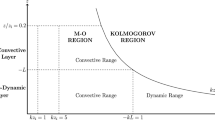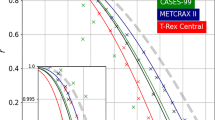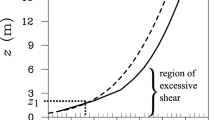Abstract
Monin–Obukhov similarity theory (MOST) is commonly used to model the wind-speed profile at altitudes relevant to wind-power production (e.g. 10–200 m). Though reasonably accurate for unstable to weakly stable stratification, this approach becomes less accurate under increasingly stable stratification, largely due to the constant-flux surface layer assumed by MOST becoming shallower than the altitude range of interest. Furthermore, above the surface layer, the Coriolis force has a considerable influence on the wind-speed profile (in particular in the formation of low-level jets) that cannot be modelled using similarity theory. Our goal is to compare the accuracy of alternative extrapolation models that are more physically appropriate above the surface layer. Using data from the 213-m Cabauw meteorological tower in the Netherlands between July 2007 and June 2008, it is shown that MOST is accurate only at low altitudes and low stability, and breaks down at high altitudes and high stability. Local similarity is generally more accurate than MOST across all altitudes and stabilities, though the model requires turbulent flux data at multiple altitudes that is generally impractical. In contrast, a two-layer MOST–Ekman model is found to be comparable to the other models at low stability ranges and considerably more accurate in the high stability range, while requiring only a measure of surface stability and the geostrophic wind.







Similar content being viewed by others
References
Baas P, Bosveld FC, Baltink HK, Holtslag A (2009) A climatology of nocturnal low-level jets at Cabauw. J Appl Meteorol Climatol 48(8):1627–1642
Baas P, van de Wiel B, van den Brink L, Holtslag A (2012) Composite hodographs and inertial oscillations in the nocturnal boundary layer. Q J R Meteorol Soc 138(663):528–535
Banta RM, Pichugina YL, Kelley ND, Hardesty RM, Brewer WA (2013) Wind energy meteorology: insight into wind properties in the turbine-rotor layer of the atmosphere from high-resolution Doppler Lidar. Bull Am Meteorol Soc 94(6):883–902
Beljaars A, Holtslag A (1991) Flux paramterization over land surfaces for atmospheric models. J Appl Meteorol Climatol 30(3):327–341
Blackadar A (1962) The vertical distribution of wind and turbulent exchange in a neutral atmosphere. J Geophys Res 67(8):3095–3102
Blackadar A (1998) Turbulence and diffusion in the atmosphere. Springer, New York, 185 pp
Burton T, Sharpe D, Jenkins N, Bossanyi E (2001) Wind energy handbook. Wiley, New York, 780 pp
Delage Y (1974) A numerical study of the nocturnal atmospheric boundary layer. Q J R Meteorol Soc 100(425):351–364
Donda JMM, Van de Wiel BJH, Bosveld FC, Beyrich F, van Heijst GJF, Clercx HJH (2013) Predicting nocturnal wind and temperature profiles based on external forcing parameters. Boundary-Layer Meteorol 146(1):103–117
Drechsel S, Mayr GJ, Messner JW, Stauffer R (2012) Wind speeds at heights crucial for wind energy: measurements and verification of forecasts. J Appl Meteorol Climatol 51(9):1602–1617
Dyer A, Hicks B (1970) Flux–gradient relationships in constant flux layers. Q J R Meteorol Soc 96(410):715–721
Emeis S (2010) A simple analytical wind park model considering atmospheric stability. Wind Energy 13(5):459–469
Emeis S (2013) Wind energy meteorology—atmospheric physics for wind power generation. Springer, Dordrecht, 150 pp
Emeis S, Baumann-Stanzer K, Piringer M, Kallistratova M, Kouznetsov R, Yushkov Y (2007) Wind and turbulence in the urban boundary layer—analysis from acoustic remote sensing data and fit to analytical relations. Meteorol Z 16(4):393–406
Etling D (2002) Theoretische Meteorologie Eine Einfuhrung, 2nd edn. Springer, Berlin, 376 pp
Garratt JR (1994) The atmospheric boundary layer. Cambridge University Press, UK, 316 pp
Giebel G (2011) The state-of-the-art in short term prediction of wind power—a literature overview, 2nd edn. ANEMOS, 109 pp
Gryning S-E, Batchvarova E (2008) Modelling of the urban wind profile. In: Borrego C, Miranda A (eds) Air pollution modeling and Its application XIX, NATO Science for Peace and Security Series Series C: Environmental Security. Springer, Dordrecht, pp 18–27
Gryning S-E, Batchvarova E, Bruemmer B, Jorgensen H, Larsen S (2007) On the extension of the wind profile over homogeneous terrain beyond the surface boundary layer. Boundary-Layer Meteorol 124(2):251–268
Kumar P, Sharan M (2012) Parameterization of the eddy diffusivity in a dispersion model over homogeneous terrain in the atmospheric boundary layer. Atmos Res 106(0):30–43
Lange M, Focken U (2005) Physical approach to short-term wind power prediction. Springer, Berlin, 167 pp
Mahrt L (1998) Stratified atmospheric boundary layers and breakdown of models. Theor Comput Fluid Dyn 11(3–4):263–279
Mahrt L (1999) Stratified atmospheric boundary layers. Boundary-Layer Meteorol 90(3):375–396
Mahrt L (2014) Stably stratified atmospheric boundary layers. Annu Rev Fluid Mech 46:23–45
Mahrt L, Vickers D (2006) Extremely weak mixing in stable conditions. Boundary-Layer Meteorol 119(1):19–39
Monin AS, Obukhov AM (1954) Basic laws of turbulence mixing in the surface layer of the atmosphere. Q J R Meteorol Soc 24:163–187
Monteiro C, Bessa R, Miranda V, Botterud A, Wang J, Conzelmann G (2009) Wind power forecasting: state-of-the-art 2009. Argonne National Laboratory, 216 pp
Motta M, Barthelmie R, Volund P (2005) The influence of non-logarithmic wind speed profiles on potential power output at Danish offshore sites. Wind Energy 8(2):219–236
Nieuwstadt F (1984) The turbulent structure of the stable, noctural boundary layer. J Atmos Sci 41(14):2202–2216
Panofsky H (1973) Tower micrometeorology. In: Haugen DA (ed) Workshop on micrometeorology. American Meteorological Society, Boston, pp 151–176
Pena A, Gryning S, Hasager C (2010) Comparing mixing-length models of the diabatic wind profile over homogeneous terrain. Theor Appl Climatol 100(3–4):325–335
Petersen EL, Mortensen NG, Landberg L, Hjstrup J, Frank HP (1998) Wind power meteorology. Part I: climate and turbulence. Wind Energy 1(1):2–22
Sathe A, Gryning S-E, Pea A (2011) Comparison of the atmospheric stability and wind profiles at two wind farm sites over a long marine fetch in the North Sea. Wind Energy 14(6):767–780
Sathe A, Mann J, Barlas T, Bierbooms WAAM, van Bussel GJW (2012) Influence of atmospheric stability on wind turbine loads. Wind Energy 16:1013–1032
Seidel DJ, Ao CO, Li K (2010) Estimating climatological planetary boundary layer heights from radiosonde observations: comparison of methods and uncertainty analysis. J Geophys Res 115(D16)
Sorbjan Z (1988) Structure of the stably-stratified boundary layer during the SESAME-1979 experiment. Boundary-Layer Meteorol 44(3):255–266
Sorbjan Z, Grachev A (2010) An evaluation of the flux–gradient relationship in the stable boundary layer. Boundary-Layer Meteorol 135(3):385–405
Stull R (1988) An introduction to boundary-layer meteorology. Kluwer, Dordrecht, 670 pp
Tennekes H (1973) Similarity laws and scale relations in planetary boundary layers. In: Workshop on micrometeorology. American Meteorological Soceity, pp 177–216
Troen I, Petersen E (1989) European wind atlas. Riso National Laboratory, Roskilde, 656 pp
Van de Wiel B, Moene A, Steeneveld G, Baas P, Bosveld F, Holtslag A (2010) A conceptual view on inertial oscillations and nocturnal low-level jets. J Atmos Sci 67(8):2679–2689
van den Berg G (2008) Wind turbine power and sound in relation to atmospheric stability. Wind Energy 11(2):151–169
Verkaik J, Holtslag A (2007) Wind profiles, momentum fluxes and roughness lengths at Cabauw revisited. Boundary-Layer Meteorol 122(3):701–719
Zilitinkevich SS (1975) Resistance laws and prediction equations for the depth of the planetary boundary layer. J Atmos Sci 32:741752
Author information
Authors and Affiliations
Corresponding author
Rights and permissions
About this article
Cite this article
Optis, M., Monahan, A. & Bosveld, F.C. Moving Beyond Monin–Obukhov Similarity Theory in Modelling Wind-Speed Profiles in the Lower Atmospheric Boundary Layer under Stable Stratification. Boundary-Layer Meteorol 153, 497–514 (2014). https://doi.org/10.1007/s10546-014-9953-z
Received:
Accepted:
Published:
Issue Date:
DOI: https://doi.org/10.1007/s10546-014-9953-z




